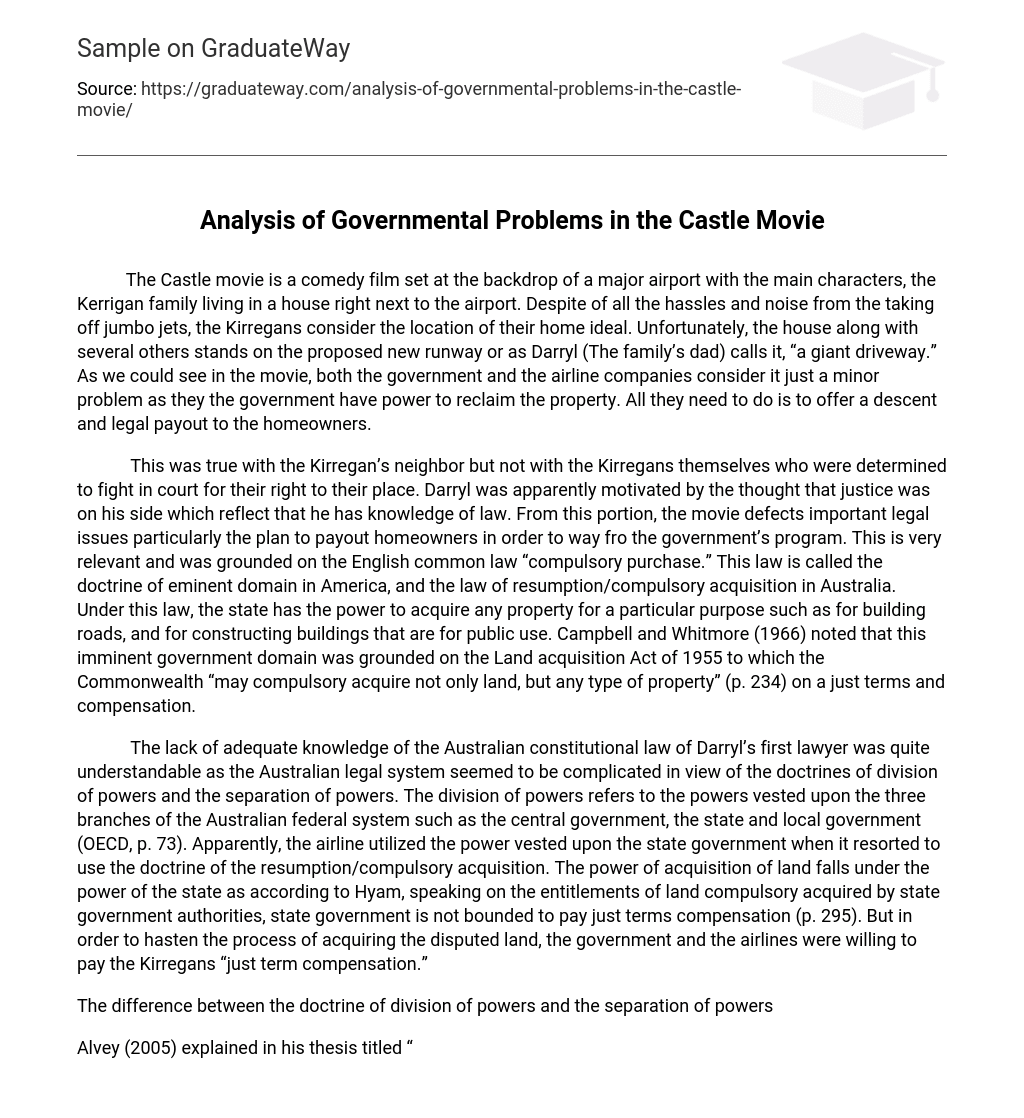The Castle movie is a comedy film set at the backdrop of a major airport with the main characters, the Kerrigan family living in a house right next to the airport. Despite of all the hassles and noise from the taking off jumbo jets, the Kirregans consider the location of their home ideal. Unfortunately, the house along with several others stands on the proposed new runway or as Darryl (The family’s dad) calls it, “a giant driveway.” As we could see in the movie, both the government and the airline companies consider it just a minor problem as they the government have power to reclaim the property. All they need to do is to offer a descent and legal payout to the homeowners.
This was true with the Kirregan’s neighbor but not with the Kirregans themselves who were determined to fight in court for their right to their place. Darryl was apparently motivated by the thought that justice was on his side which reflect that he has knowledge of law. From this portion, the movie defects important legal issues particularly the plan to payout homeowners in order to way fro the government’s program. This is very relevant and was grounded on the English common law “compulsory purchase.” This law is called the doctrine of eminent domain in America, and the law of resumption/compulsory acquisition in Australia. Under this law, the state has the power to acquire any property for a particular purpose such as for building roads, and for constructing buildings that are for public use. Campbell and Whitmore (1966) noted that this imminent government domain was grounded on the Land acquisition Act of 1955 to which the Commonwealth “may compulsory acquire not only land, but any type of property” (p. 234) on a just terms and compensation.
The lack of adequate knowledge of the Australian constitutional law of Darryl’s first lawyer was quite understandable as the Australian legal system seemed to be complicated in view of the doctrines of division of powers and the separation of powers. The division of powers refers to the powers vested upon the three branches of the Australian federal system such as the central government, the state and local government (OECD, p. 73). Apparently, the airline utilized the power vested upon the state government when it resorted to use the doctrine of the resumption/compulsory acquisition. The power of acquisition of land falls under the power of the state as according to Hyam, speaking on the entitlements of land compulsory acquired by state government authorities, state government is not bounded to pay just terms compensation (p. 295). But in order to hasten the process of acquiring the disputed land, the government and the airlines were willing to pay the Kirregans “just term compensation.”
The difference between the doctrine of division of powers and the separation of powers
Alvey (2005) explained in his thesis titled “The Separation of Powers in Australia: Implications for the State of Queensland” how the doctrine of division of powers differs to the doctrine of separation of powers. According to Alvey, the doctrine of separation of powers refers to the powers vested upon the executive, legislative, and the judicial powers which are a lower level powers in the sense that these powers are limited compared to the doctrine of the division of powers. For instance, the Commonwealth power is divided between the legislature, the executive, and the judiciary. Creyke explained this limitation stating that the Commonwealth judicial power cannot be exercised by the executive but only by the judiciary in the same way that reviewing administrative decision on the merits is not a function of the judiciary but by the executive (p. 4). In other words, the difference between the division of powers and separation of powers refers to collective power of each of the three braches of the federal government namely the Commonwealth, the state, and the local government while the separation of powers refers to the powers of each branch separated into the three functions namely executive, judiciary, and legislative.
References
Alvey, J. (2005) The Separation of Powers in Australia: Implications for the State of Queenslan http://auspsa.anu.edu.au/proceedings/publications/Alveypaper.pdf
Cambel,E. & Whitmore, H. (1966) Freedom in Australia Australia: Sidney University Press
Creyke, R. Tribunals in the Common law Sidney: Federation Press
Hayam, A.A. (2009) The Law Affecting Valuation of Land in Australia Sidney: The Federation Press
OECD Economic Surveys: Australia 2006





